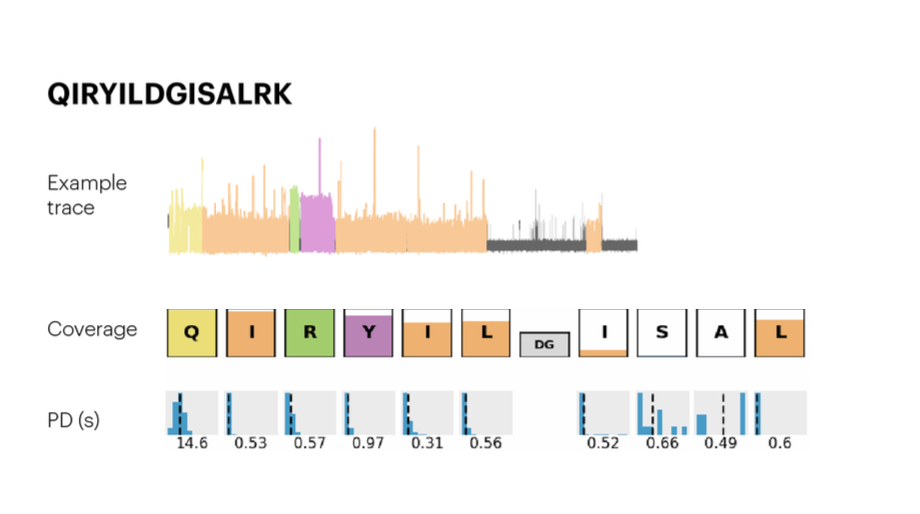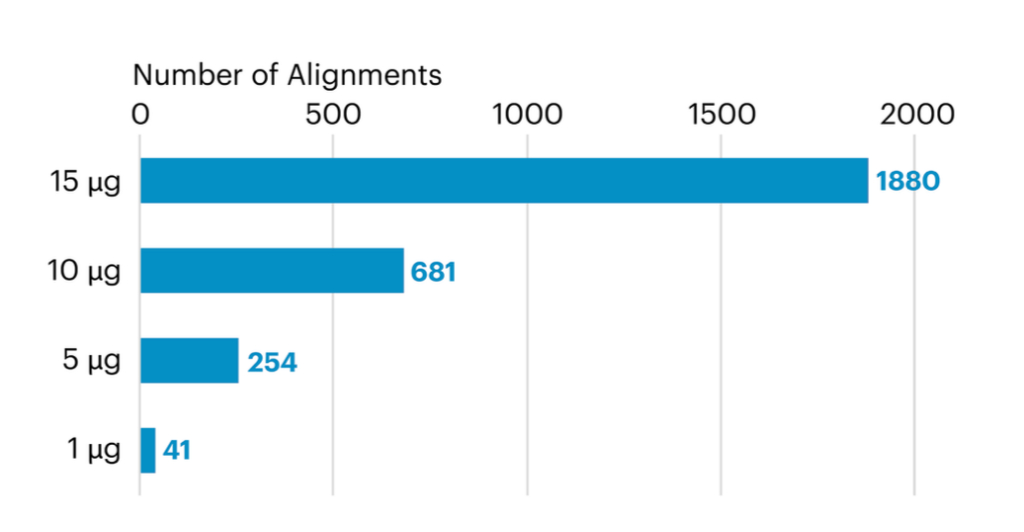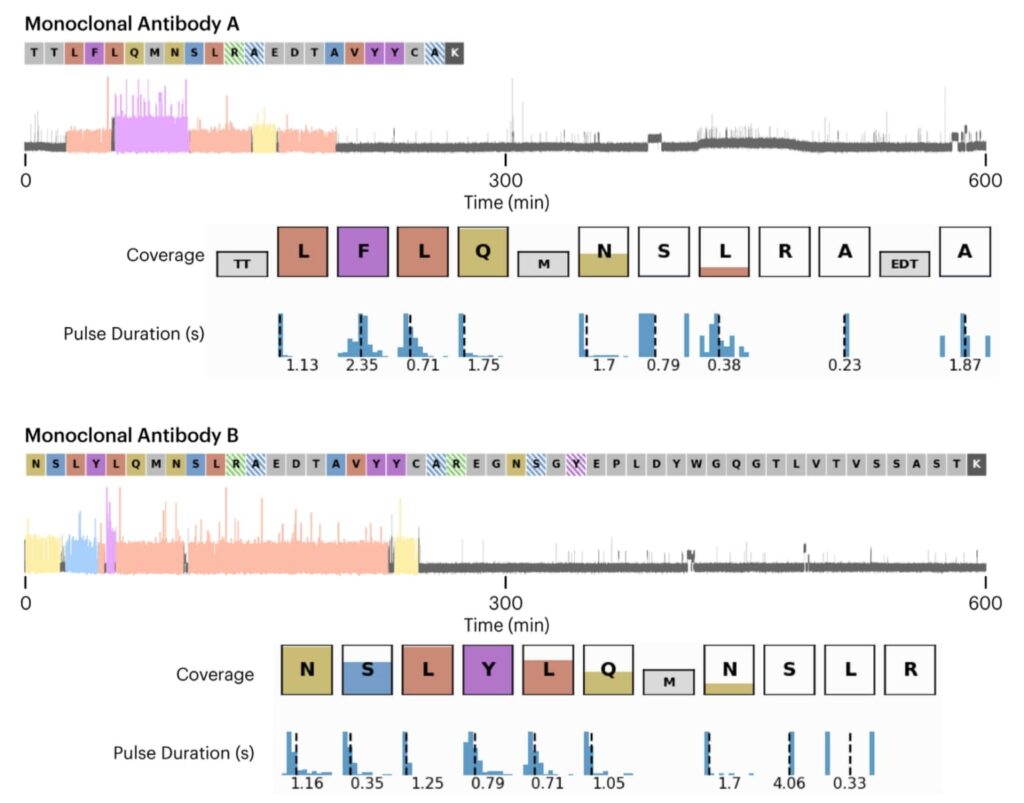High-Resolution Antibody Sequencing and Characterization with Platinum® Pro
Harness the power of Next-Gen Protein Sequencing™ (NGPS™) to gain deeper antibody insights necessary for advancing research and development.
Learn More About Platinum Pro
Confirm specificity to ensure the antibody binds exclusively to its target antigen
Assess affinity to identify the most effective antibody variants
Evaluate purity to prevent any contaminants from affecting antibody function
Discover binding partners of your protein target in co-immunoprecipitation reactions
Antibodies are key molecules used in research and medicine to detect, target, and neutralize specific proteins or pathogens. Antibody sequencing can help determine antibody class, binding affinity, epitope specificity, and cross-reactivity. This process is key to understanding the safety and efficacy of biotherapeutics, providing critical insights that drive effective drug development.
Platinum Pro’s single-molecule protein sequencing technology puts the power of comprehensive antibody characterization right at researchers’ fingertips. From confirming specificity to assessing affinity and evaluating purity, this innovative tool brings all of these critical insights directly to the bench.
With NGPS, researchers can ensure antibodies bind precisely to their target antigens with maximum efficiency, while easily detecting and eliminating any contaminants that might interfere with performance. It’s a seamless way to unlock deeper understanding and boost the quality of every experiment.
Talk to an ExpertExplore our resources to discover how Platinum Pro can elevate your antibody research and development:
-
Identifying Cancer-Specific Proteins Using Next-Gen Protein Sequencing — CASE STUDY
Sanavia Oncology is focused on developing antibody therapeutics targeting novel cancer markers, and plans to utilize Next-Gen Protein Sequencing™ to better characterize novel cancer targets, which is a crucial tool in their target identification workflow.
-
Immunoprecipitation of IL-6 from Human Serum for Next- Generation Protein Sequencing™ on Platinum® — APP NOTE
The application note explores the enhancement of scarce proteins from complex biological matrices, a crucial phase in numerous proteomic workflows. It presents a cutting-edge immunoprecipitation method tailored for Quantum-Si’s advanced protein sequencing workflow. This on-bead digestion approach directly formulates digested peptide libraries, eliminating the need for a sample elution step. Its efficacy is demonstrated by enriching IL-6 from human serum and subsequently sequencing and identifying it with Platinum.
See the transformative power of this novel immunoprecipitation method by accessing the complete application note now.
The application note showcases an all-inclusive process for on-bead digestion and immunoprecipitation of proteins, setting the stage for cutting-edge protein sequencing. This detailed procedure underscores the smooth progression from protein capture to its readiness for sophisticated sequencing, underscoring the method’s innovative and efficient nature.
Here we highlight the nuanced data of traces, coverage, and pulse duration for peptides identified in IL-6 immunoprecipitated from PBS. Employing five recognizers, the research effectively pinpoints 12 amino acids, resulting in the detection of three unique peptides.


This insightful analysis showcases the count of aligned IL-6 peptides found in each immunoprecipitated serum sample. Beyond highlighting the method’s efficacy, the data provides a deeper understanding of the correlation between input concentration and sequencing results.
-
Identifying Monoclonal Antibodies with Quantum-Si’s Next-Generation Protein Sequencing™ Technology — APP NOTE
Detecting rare monoclonal antibodies within a polyclonal antibody group is vital for grasping disease processes, diagnostics, among other aspects. While conventional techniques have their merits, they often entail significant expenses, intricacy, and lengthy protocols. This application note unveils Quantum-Si’s advanced protein sequencing approach using the Platinum device, offering a remedy to these hurdles and adeptly pinpointing these essential antibodies.
Discover this revolutionary approach and its prospective significance by accessing the complete application note.

Here we highlight the sequencing data of distinct peptides originating from two separate monoclonal antibodies. Gathered over a span of 10 hours, the data illustrates the recognition segments (RS) with coverage denoted by the color intensity in each box, paired with the pulse duration distribution. This depiction aptly showcases the Platinum instrument’s proficiency in precise sequencing and pinpointing peptides exclusive to each antibody.
-
Measuring Nanobody Kinetics at the Single-Molecule Level— POSTER
Antibodies are a paradigm for high-affinity, protein-based binding reagents and are extremely important in biotechnological, diagnostic, and therapeutic applications. Of special interest are nanobodies, recombinant variable domains from heavy-chain-only antibodies.
Despite their benefits, nanobodies have only recently been used in single-molecule assays, e.g., PAINT imaging, which require careful tuning of their kinetic properties. In this work, we demonstrate the detection of nanobody-antigen binding at the single-molecule level.
-
Multiplexing Nanobody Kinetics Measurements at the Single-Molecule Level — POSTER
Single-molecule methods provide useful insights into the intermolecular variations and functional differences of individual molecules and have revealed much about the complexity of biological processes. Today it is possible to monitor binding kinetics at the single molecule level in a highly parallel fashion using zero-mode waveguide (ZMW) arrays. This allows monitoring the binding/unbinding of fluorescently labelled molecules on millions of immobilized targets simultaneously, obtaining a full kinetic description of their interactions, offering a complementary picture to classical techniques but also uncovering important details that are missed in bulk studies.
In our work, we use ZMW arrays to study the binding kinetics of antibody-antigen interactions at the single-molecule level. Moreover, we demonstrate that it is possible to couple these binding kinetics measurements with single-molecule protein sequencing to multiplex kinetic analysis to panels of nanobodies. This new approach to the study of nanobodies will help us understand the sequence/function relationship in nanobodies and open new directions in nanobody affinity maturation.